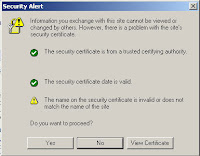
Security concerns, including viruses, denial of service attacks, and spyware/malware, have made firewalls (both software and hardware) a critical part of having an internet connection today. Without testing it, how do you know that your firewall is doing its job? We will look at how to test your firewall.
Step 1 : If you have a firewall, hardware, software, or both, make sure that it is enabled.
Step 2 : Find a computer security test site. I use ShieldsUP! from grc.com and the QuickTest from PCFlank.com. Run the test and review the results.
Step 3 : The first results to review are the ports shielding or stealthing. This tests to see if the ports (different doors) to your computer's address are visible from the internet. Having them hidden, prevents your computer from being "found" by a computer or person that wants to take control of it.
If there are ports that are not hidden, but should be according to the test tool, then refer to the documentation for your hardware firewall (usually part of a router) or software firewall. Look for the section on port rules.
Add rules to hide the ports that should be, but aren't.
Step 4 : Test your new rules with the security test tool to make sure that the rules worked correctly and hid the ports. Also test to make sure that your internet connection still works correctly.
Step 5 : Another test run by these tools is to attempt to get information about your browser (e.g.- Internet Explorer or FireFox). If the test results show that you have a problem, refer to the documentation for your software firewall. Look for information on privacy.
Add or modify the rules to hide your browser information.
Step 6 : Again, retest with your new rules in place to ensure that they are working correctly and hiding your browser information. Also, make sure that you can still browse correctly.
Step 7 : Feel just a little bit safer when browsing the internet.
Thursday, August 20, 2009
Test your Computer Securit
Monday, August 17, 2009
How can I remove adyieldmanager from my pc
This is server based adware/spyware.
To remove ad.yieldmanager.com cookie with Internet Explorer 6, 5, 5.01, and 5.5 for Windows 95, Windows 98, Windows NT 4.0 and Windows 2000, follow the manual removal steps below:
1. Start Internet Explorer.
2. Go to Tools > Internet Options > General tab.
3. In the Temporary Internet Files, select Settings > View Files.
4. On the View, select Details.
5. Click the Internet Address column header, and search for the Internet addresses of the cookie file(s) below:
6. Right-click on the ad.yieldmanager.com cookie file, and then press Delete. If you are prompted to confirm that you wish to delete the ad.yieldmanager.com cookie file, click Yes. You can repeat this step for each cookie file you want to remove.
Wednesday, August 12, 2009
How to secure unsecured wireless network?

Step 1 : Open “Network Connections” on your PC or laptop. If you do not have an Icon or specific file for network connections, it can be located under the “Control Panel” in the main menu. If you are connected to a network already it will show if it is an “unsecured wireless network” or “security-enabled wireless network.”
Step 2 : Find your default username and password for your router. Access your router by entering the default IP address of 192.168.0.1 (or a similar IP address - this number varies depending on the manufacturer) in your browser. If you are having difficulty accessing your wireless network or settings verify that your firewall or other Internet Security settings are not blocking your attempts to secure your network.
Step 3 : Log into your wireless router. Click the link for “Security” or similar link to access the security settings for your wireless network connection.
Step 4 : Set the authentication type to WPA. (WPA stands for Wireless Protection Access.)
Step 5 : Change the password or “Key” from the default setting to your personal password setting. This will prevent others from accessing your wireless router and its settings with the default password. Write down the password and keep it somewhere safe since you will not be using it often.
Step 6 : Turn the “Remote Management” setting to “Off.” This way changes can only be made to your wireless network connection by a computer already in the network. This makes it more difficult for hackers to access your wireless settings and the computers attached to your wireless network.
Step 7 : Click “Save” or “Apply” to save the changes you made to the settings. Close the Network Connections window.
Step 8 : Reopen the “Network Connections” window. Your connection should display as a “security-enabled wireless network” if your changes were saved successfully.